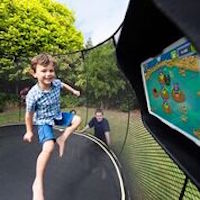 If you have children with access to a tablet (and most New Zealand children now do), you will know how addictive they can be. You will probably also have heard about links between excessive device use and obesity, along with other health issues, including sight problems.
If you have children with access to a tablet (and most New Zealand children now do), you will know how addictive they can be. You will probably also have heard about links between excessive device use and obesity, along with other health issues, including sight problems.
Childhood obesity is a very real problem in New Zealand and in many developed nations. International studies show that some kids are spending more than 60 hours per week consuming media and less than 60 minutes playing outside. The New Zealand Health Survey shows over 30 percent of New Zealand children aged two to fourteen are either obese or overweight. Professor Barry Taylor, Dean of Canterbury University’s School of Medicine says obesity is likely to overtake tobacco as the leading preventable risk to health in New Zealand within the next 12 months.
“With significantly increasing child obesity rates a national problem, a great deal of research is now going into focusing on prevention and management of this issue,” says Professor Taylor.
Now, a Kiwi company has developed a product which utilises children’s love of technology, and the timeless enjoyment of bouncing on a trampoline. The idea is to set children fitness targets, through a gaming app, so they can increase their activity levels and spend more time outdoors.
The system, created by Christchurch-based Springfree Trampoline, uses mat sensors to detect trampoline jump location, jump height, and even calorie-burn rate, and converts it using a patented algorithm to encourage the child to play games, using their entire body as the controller.
The tgoma – an acronym for ‘take gaming outside & make it active’ was developed in conjunction with sports science specialists.
Jonathan Collins, tgoma product manager, says the device leverages technology to shift screen time from being a sedentary activity to being an active experience, with significant wellness benefits. “The ‘gamification’ of fitness is a rapidly growing trend globally, essentially it is bringing together elements of the digital gaming industry and augmenting traditional fitness activities. The aim is to find new ways to engage the mind as well as the body during exercise,” he says.
While many exergames are used indoors, the Springfree tgoma was designed to take gaming outside where it can be a fully active, whole-body, fresh-air experience for kids.
“We wanted to create something which could deliver health benefits from cardiovascular fitness to musculoskeletal strengthening in a fun and compelling way which merges exercise with play,” says Jonathan.
Dr. Carl Petersen, from Canterbury University says the technology underlying tgoma is new and involved extensive research and testing. The device was calibrated with university students paid to jump over 1.2 million times.
Have a look at the system in action below.










Join the Discussion
Type out your comment here:
You must be logged in to post a comment.